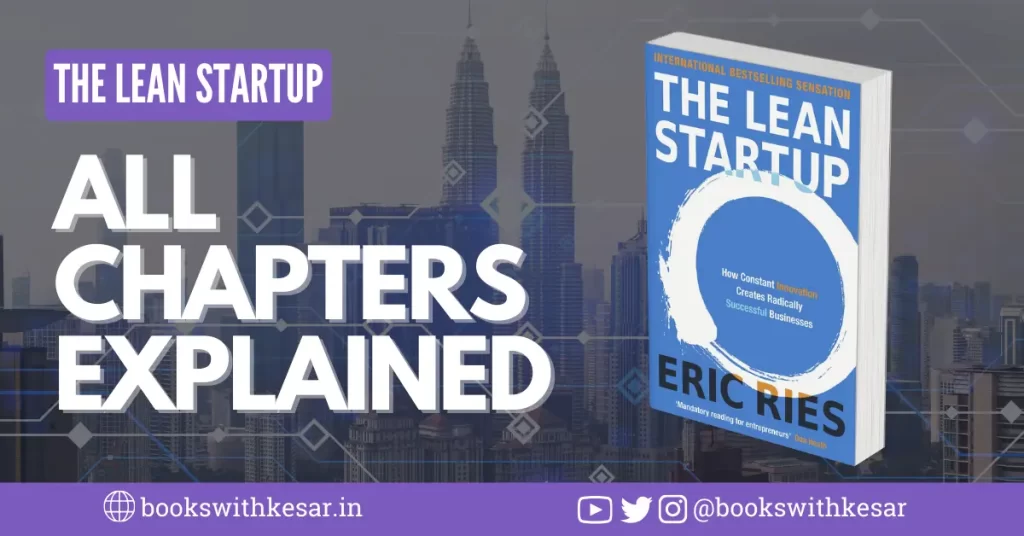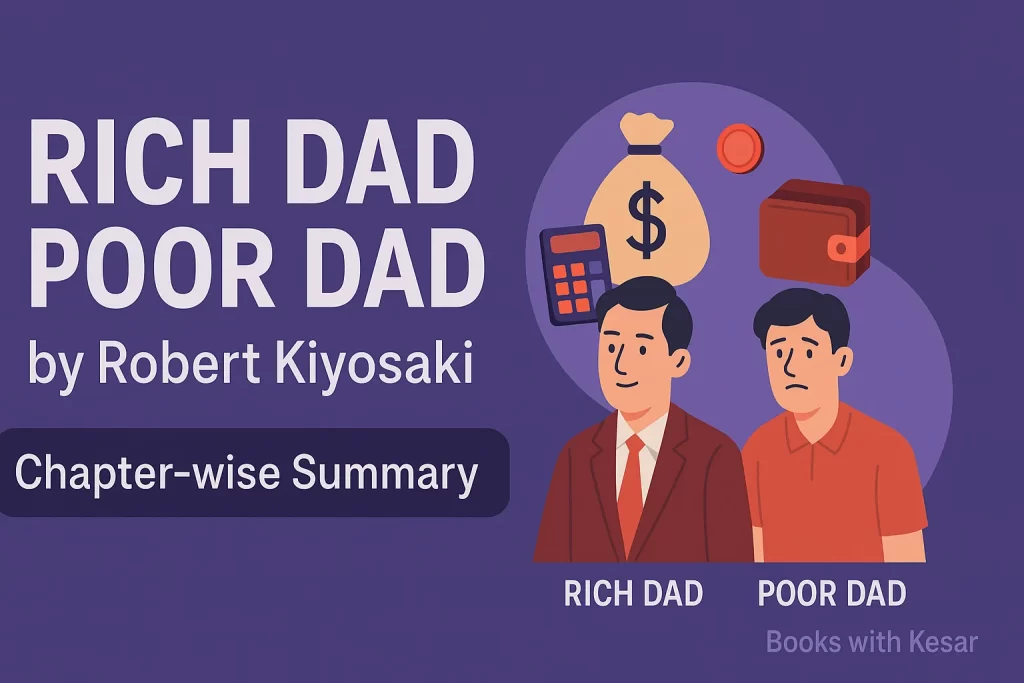
Let’s cut the fluff—most startups fail. And not because the founders weren’t smart enough or the idea wasn’t good. They fail because they waste time, money, and energy building things nobody wants.
You’ve seen the story before. Some overconfident entrepreneur burns through funding, launches with a flashy press release, and… crickets. No customers. No traction. Just a bunch of useless “vanity metrics” that make it look like progress—while the bank account bleeds out.
Eric Ries wrote The Lean Startup to kill this madness. He’s been there. He’s built a startup that crashed and burned, and he’s built one that thrived. What he figured out? Startups aren’t about having a genius idea. They’re about testing, learning, and adapting—fast.
This book flips traditional entrepreneurship on its head. Forget long business plans, massive product launches, and gut-feeling decisions. Ries introduces a system that’s built for speed, agility, and survival in a world where uncertainty is the only certainty.
If you’re an entrepreneur (or thinking of becoming one), this book is your BS-free roadmap to making sure your startup doesn’t become just another statistic. Let’s dive in.
Want This Book for Free? Start Your Audible Trial & Own Your First Audiobook—Even If You Cancel!
Table of Contents
ToggleChapter 1: Start – Entrepreneurial Management
Most people think of startups as wild, chaotic, anything-goes operations—where genius founders hustle their way to success. Wrong. A startup is not just a product; it’s an institution. And institutions need management.
The problem? Traditional management doesn’t work in startups. It’s built for predictable environments, where the future looks like the past. But startups operate in extreme uncertainty. The rules are different. That’s why most fail.
Eric Ries makes it clear: Entrepreneurship is a form of management—just a different kind. Startups need a system that helps them navigate uncertainty, experiment rapidly, and learn what actually works before they run out of time and money. This is where The Lean Startup methodology comes in.
Instead of wasting months (or years) on business plans based on guesses, founders should focus on validated learning. They should test ideas, measure real customer reactions, and adapt—fast. The goal isn’t to build the perfect product; it’s to find what people truly want and will pay for.
In short? A startup isn’t a smaller version of a big company. It’s a different beast entirely. And if you don’t manage it differently, you’re setting yourself up for failure.
Chapter 2: Define – What Is a Startup?
If you think startups are just small companies, you’re already setting yourself up to fail. Ries redefines what a startup really is:
“A startup is a human institution designed to create a new product or service under conditions of extreme uncertainty.”
This means:
Size doesn’t matter. A startup can be a one-person operation or a team inside a giant corporation.
Industry doesn’t matter. It could be a tech company, a nonprofit, or even a government project.
What matters? Uncertainty. If you’re working on something new without guaranteed success, you’re running a startup.
This chapter also shatters the “just hustle harder” myth. Startups fail not because founders lack grit but because they chase wrong ideas with the wrong process. Instead of assuming what customers want, you need a systematic way to test, learn, and adapt.
And here’s the big takeaway: If a startup is an experiment, its success isn’t about having a perfect plan—it’s about how fast you can learn what works.
Chapter 3: Learn – Validated Learning Over Guesswork
Forget the fantasy of the lone genius who magically builds a billion-dollar startup from sheer intuition. That’s Hollywood nonsense. In reality, most founders have no clue what will work. And that’s okay—as long as they learn fast.
Ries introduces the concept of validated learning—the real currency of a startup. This isn’t just gathering random insights or hearing customers say, “That sounds cool.” It’s about running experiments, getting real data, and proving (or disproving) your assumptions.
Here’s how most startups screw up:
They spend months (or years) building a “perfect” product.
They finally launch it.
Nobody cares.
That’s because they never tested if their idea was actually wanted. Validated learning stops you from making this fatal mistake. It forces you to build just enough of your product to test a key assumption and then measure real customer behavior (not opinions).
The lesson? Don’t waste time perfecting a product nobody wants. Instead, constantly test and adjust—because success comes from learning what works, not from executing a flawless plan that leads nowhere.
Chapter 4: Experiment – The Power of the Minimum Viable Product (MVP)
Most founders dream of a perfect launch. They want to build something polished, fully-featured, and impressive. That’s a rookie mistake.
Why? Because your first version will be wrong. No matter how smart you are, you don’t actually know what customers want until you test it in the real world.
That’s where the Minimum Viable Product (MVP) comes in. An MVP is the smallest, simplest version of your idea that allows you to start learning right now. Instead of waiting months (or years) to release something fully built, you launch fast, gather data, and improve based on real customer feedback.
Example: Zappos’ MVP wasn’t a massive online shoe store. The founder just took photos of shoes from local stores, posted them online, and bought the shoes himself whenever someone placed an order. Zero inventory, zero warehouses—just a test to see if people would buy shoes online.
Here’s the mindset shift:
The goal of an MVP isn’t to impress people—it’s to learn.
It should be embarrassing. If you’re not a little ashamed of your first version, you launched too late.
It’s about data, not opinions. Customers vote with their actions, not their words.
Bottom line? Perfection kills startups. Launch fast, learn fast, and improve fast—or die slow.
Chapter 5: Leap – Testing Assumptions Before They Kill Your Startup
Every startup is built on assumptions. The problem? Most of them are wrong.
Founders love to believe they “just know” what customers want. But the brutal reality is this: Your biggest risks aren’t technical—they’re assumptions about what people actually need and will pay for.
Ries calls these “leap-of-faith assumptions.” They come in two forms:
Value Hypothesis – Does your product actually solve a problem customers care about?
Growth Hypothesis – Will your product spread and attract enough customers to sustain your business?
Most startups fail because they build first and test later. The smarter approach? Identify and test your riskiest assumptions as early as possible.
Example: Before building a single car, Tesla took pre-orders. They weren’t just raising money—they were testing whether people would actually pay for an electric car before investing billions in production. That’s smart entrepreneurship.
Key takeaways:
Your gut feeling is not a business strategy.
If your core assumption is wrong, nothing else matters.
Test before you build, not after.
Lesson: The faster you challenge your assumptions, the faster you get to a business that actually works.
Chapter 6: Test – Get Out of the Building and Talk to Customers
Newsflash: Your startup is not the center of the universe. You might think your idea is revolutionary, but if customers don’t care, it’s worthless.
Most founders sit in their offices guessing what customers want. That’s a death trap. Ries pushes you to do something radical: get out of the building. Talk to real people. Watch their behavior. See what they actually do—not just what they say.
This chapter introduces Customer Development, a concept from Steve Blank. The idea? Stop assuming and start testing. Instead of relying on surveys or market research, you need real-world validation.
Here’s how to test properly:
Find your early adopters – These are the people desperate for a solution, not just mildly interested.
Observe their actions, not opinions – People say one thing but do another.
Adjust your product based on real feedback – If nobody’s excited, you’re solving the wrong problem.
Example: Dropbox didn’t waste years building a full product. Instead, they released a simple explainer video to see if people would sign up. The response? Thousands joined the waitlist overnight. That was real validation—without writing a single line of code.
Big lesson?
Stop guessing. Start testing.
If your idea can’t survive real customer interaction, it won’t survive the market.
The truth about your business is outside the building—not in your head.
Chapter 7: Measure – Stop Lying to Yourself with Vanity Metrics
Here’s the brutal truth: Most startups track the wrong metrics and fool themselves into thinking they’re making progress.
Founders love to celebrate big numbers—downloads, website traffic, social media likes. But here’s the catch: these “vanity metrics” don’t mean your business is actually working.
Ries introduces “Innovation Accounting”—a smarter way to measure progress. Instead of feel-good numbers, you track real customer behavior to see if your startup is truly growing.
Here’s what to focus on:
Cohort Metrics – Instead of total users, track how many stick around and actually use your product.
Conversion Rates – Are people signing up AND paying? Or just browsing?
Customer Retention – Are users coming back, or trying your product once and disappearing?
Example: Imagine launching an app that gets 100,000 downloads. Sounds great, right? But if 99,500 people delete it after a week, your startup is failing—no matter how big the number looks.
Key takeaways:
If a metric makes you feel good but doesn’t drive decisions, it’s useless.
Growth isn’t about big numbers—it’s about retaining and monetizing customers.
The only numbers that matter are the ones that tell you what’s actually working.
Lesson: If you’re not measuring real progress, you’re just burning money.
Chapter 8: Pivot (or Persevere) – The Startup’s Make-or-Break Moment
At some point, every startup faces a brutal decision: Keep going or change direction?
You’ve built your product, tested it, measured the results—and now the data is staring you in the face. Either:
You’re seeing real traction. Customers love your product, and growth is happening. → Persevere.
Your numbers are flatlining. Customers aren’t sticking around, and no amount of tweaking is fixing it. → Time to pivot.
A pivot isn’t a failure—it’s a strategy shift based on real learning. Ries emphasizes that the best startups don’t stubbornly cling to bad ideas—they adapt.
Types of Pivots:
Zoom-In Pivot: One small feature is getting all the love? Make it your whole product.
Zoom-Out Pivot: Your product isn’t enough? Customers need a bigger solution.
Customer Pivot: You’ve built something useful—but for the wrong audience.
Technology Pivot: Your tech is solid, but its application needs to change.
Example:
Instagram started as a location-based social network with tons of features. But users only cared about one thing—photo sharing. Instead of clinging to their bloated idea, the founders pivoted—and created one of the most successful apps ever.
Key Takeaways:
Pivots separate stubborn failures from smart entrepreneurs.
If the data says your idea isn’t working, stop doubling down on a losing bet.
Success comes from learning fast, not from sticking to a broken plan.
Lesson: Knowing when to pivot can mean the difference between a billion-dollar company and a dead startup.
Chapter 9: Batch – Why Doing Less (at Once) Speeds You Up
Most startups think big batches = efficiency. They build tons of features, test everything at once, and then launch a massive update. Sounds smart, right? Wrong.
The big batch approach leads to slow progress, wasted effort, and massive failures. If something doesn’t work, you have no idea what went wrong—because too many changes happened at once.
The Lean Approach: Small Batches
Ries argues that startups should work like Toyota’s lean manufacturing system. Instead of dumping everything into a huge release, work in small, rapid cycles.
Why small batches work better:
Faster feedback: You see what works immediately, instead of waiting months.
Less waste: You don’t spend time perfecting features nobody wants.
Easier troubleshooting: If something breaks, you know exactly what caused it.
Example:
Imagine you’re baking cookies. Would you:
Make 100 cookies at once, only to realize at the end that you forgot sugar?
Make a small test batch first, taste them, and adjust before making more?
Startups should be like the second option—test small, fix mistakes fast, and scale up only when you know it works.
Key Takeaways:
Big launches = big risks. Small iterations = safer, faster progress.
Don’t waste months building something before testing if it even works.
The faster you test, the faster you learn—and the faster you succeed.
Lesson: Speed isn’t about working harder—it’s about working smarter.
Chapter 10: Grow – How Startups Actually Scale
Forget the myth that great products magically “go viral.” Real growth isn’t luck—it’s engineered.
Ries breaks down three proven engines of growth that startups use to scale:
1. The Sticky Engine (Keep Customers Coming Back)
Focus: Retention.
If customers love your product, they’ll keep using it—and tell others.
Metric to track: Churn rate (how many customers stop using your product).
Example: Facebook—once people start using it, they rarely leave.
2. The Viral Engine (Customers Bring More Customers)
Focus: Word-of-mouth and referrals.
Growth happens because existing users bring in new users—organically.
Metric to track: Viral coefficient (how many new users each customer brings).
Example: Dropbox’s referral program—users got extra storage for inviting friends.
3. The Paid Engine (Pay for Growth, But Smartly)
Focus: Advertising and paid acquisition.
Works when the cost to acquire a customer (CAC) is lower than the revenue they generate (LTV – lifetime value).
Metric to track: Return on investment (ROI) of each marketing dollar spent.
Example: Google Ads—businesses pay to acquire customers profitably.
Key Takeaways:
Growth isn’t magic—it’s a system. You need to pick and optimize the right engine.
If customers leave faster than they arrive, you’re dead—fix retention first.
Don’t waste money on ads if your product isn’t sticky.
Lesson: Startups don’t grow by chance—they grow by design.
Chapter 11: Adapt – Why Startups Must Embrace Change (or Die)
Most companies don’t fail because of one big mistake—they fail because they ignore small problems until it’s too late.
Ries argues that startups must be built to adapt. If you’re not constantly learning, tweaking, and improving, you’re on a slow march to failure.
How to Build an Adaptive Startup:
Set Up a Continuous Feedback Loop
Don’t wait for a crisis. Regularly analyze what’s working and what’s not.
Example: Toyota’s “andon cord” system—any worker can stop production to fix a problem immediately.
Create a Culture Where It’s Safe to Fail
Employees should feel comfortable reporting problems early.
If people are scared to fail, they’ll hide mistakes until they explode.
Example: Amazon’s “Day 1” mentality—always act like a startup, always keep improving.
Kill Zombie Projects
If something isn’t working, cut it fast.
Don’t fall into the “sunk cost fallacy” trap—wasting more time and money on something failing.
Example: Netflix killed its DVD rental business to go all-in on streaming. That pivot saved the company.
Key Takeaways:
Rigidity kills startups. Adaptability keeps them alive.
A startup should always be in learning mode—analyzing, testing, and adjusting.
Failure isn’t the enemy—stubbornness is.
Lesson: If your startup can’t adapt, the market will crush you.
Chapter 12: Innovate – How to Keep the Startup Mentality Alive
Most companies start with bold ideas and fearless innovation—then they grow, get comfortable, and turn into slow, bureaucratic dinosaurs.
Ries warns: Innovation dies when companies prioritize “business as usual” over experimenting with new ideas. If you don’t keep evolving, you’ll get disrupted.
How to Keep Innovation Alive:
Give Teams Autonomy
Innovation can’t happen under micromanagement.
Create small, independent teams with the freedom to test and launch new ideas.
Example: Google’s famous “20% time” let employees work on side projects—leading to Gmail and Google Maps.
Create an Internal Startup Culture
Big companies should run innovation teams like startups—fast, lean, and experimental.
Instead of long business plans, fund ideas based on real customer feedback.
Example: Amazon Web Services (AWS) started as an internal experiment—now it’s a billion-dollar business.
Measure Innovation, Not Just Efficiency
Traditional KPIs (profits, efficiency) kill new ideas before they can grow.
Instead, measure learning milestones—how fast teams are testing and validating new concepts.
Key Takeaways:
Innovation isn’t a one-time event—it’s a continuous process.
Companies that stop experimenting eventually become obsolete.
The best companies act like startups—even when they’re huge.
Lesson: If you don’t disrupt yourself, someone else will.
Chapter 13: Epilogue – Waste Not
Most startups fail not because they lack ideas, but because they waste time, money, and effort on the wrong things.
Ries ends the book with a challenge: What if we stopped wasting resources and started building companies that actually create value?
The Biggest Wastes in Startups:
Building products nobody wants.
Relying on gut feelings instead of real customer feedback.
Spending years perfecting something before testing it.
The Lean Startup Solution:
Test ideas immediately.
Measure real customer behavior, not vanity metrics.
Pivot fast when things aren’t working.
The goal? A world where innovation isn’t about gambling—it’s about learning. A world where startups don’t just “fail fast,” but learn fast.
Final Takeaway:
“The big idea behind The Lean Startup is that we can create a system for innovation. A startup is an experiment, and its success depends on how fast it can learn.”
Lesson: Success isn’t about having the right idea—it’s about building the right process.
Chapter 14: Join the Movement – The Future of Lean Startups
Ries doesn’t just want The Lean Startup to be a book—he wants it to be a movement. He argues that the principles of Lean Startup don’t just apply to tech companies—they apply to every industry, from healthcare to government.
Why This Matters:
Big companies need to act like startups if they want to stay competitive.
Governments and nonprofits can use Lean principles to solve real problems faster.
Even individuals can use this mindset to test ideas before making big career or life decisions.
How to Get Involved:
Join Lean Startup communities that discuss and test these principles.
Attend Lean Startup conferences to learn from real-world case studies.
Apply Lean methods not just in business, but in daily decision-making.
The Big Idea:
The world is changing too fast for old-school business methods. Companies that don’t adapt will die. The Lean Startup is about building a system that constantly learns, adapts, and innovates.
Final Lesson:
You don’t have to be a founder to think like a startup. The future belongs to those who can learn and evolve—fast.
⚡ Want to Get This Life-Changing Book at the Best Price? Check Amazon Now!
🔸 Buy on Amazon India (🛒 Trusted by Millions)
🔹 Buy on Amazon (US, UK & More) (📦 Fast Worldwide Shipping)
👉 This post contains affiliate links. If you buy through these links, I may earn a small commission at no extra cost to you—thanks for your support!
💡 Enjoyed this summary? Support Books with Kesar by donating here.
📢 Never miss an update! All new summaries are now on Telegram—Join the Channel.
📚 Want more insightful reads? check out these articles next:
Book Summary: The Psychology of Money (All chapters explained)
Book Summary: The Art of Work by Jeff Goins (All Chapters Explained)
The Richest Man in Babylon Summary (All Chapters Explained)
Book Summary: Rich Dad Poor Dad by Robert Kiyosaki (All Chapters Explained)


